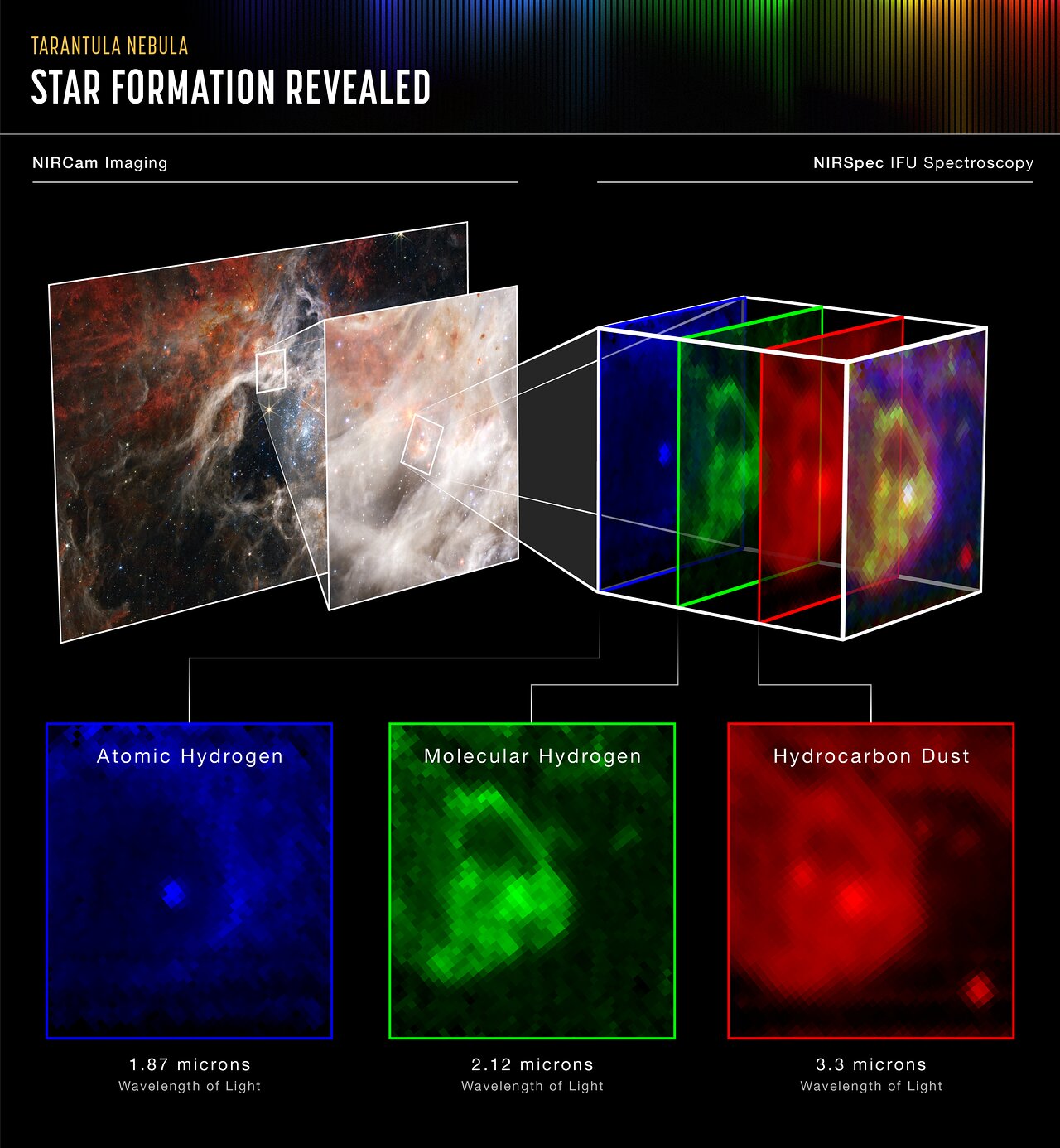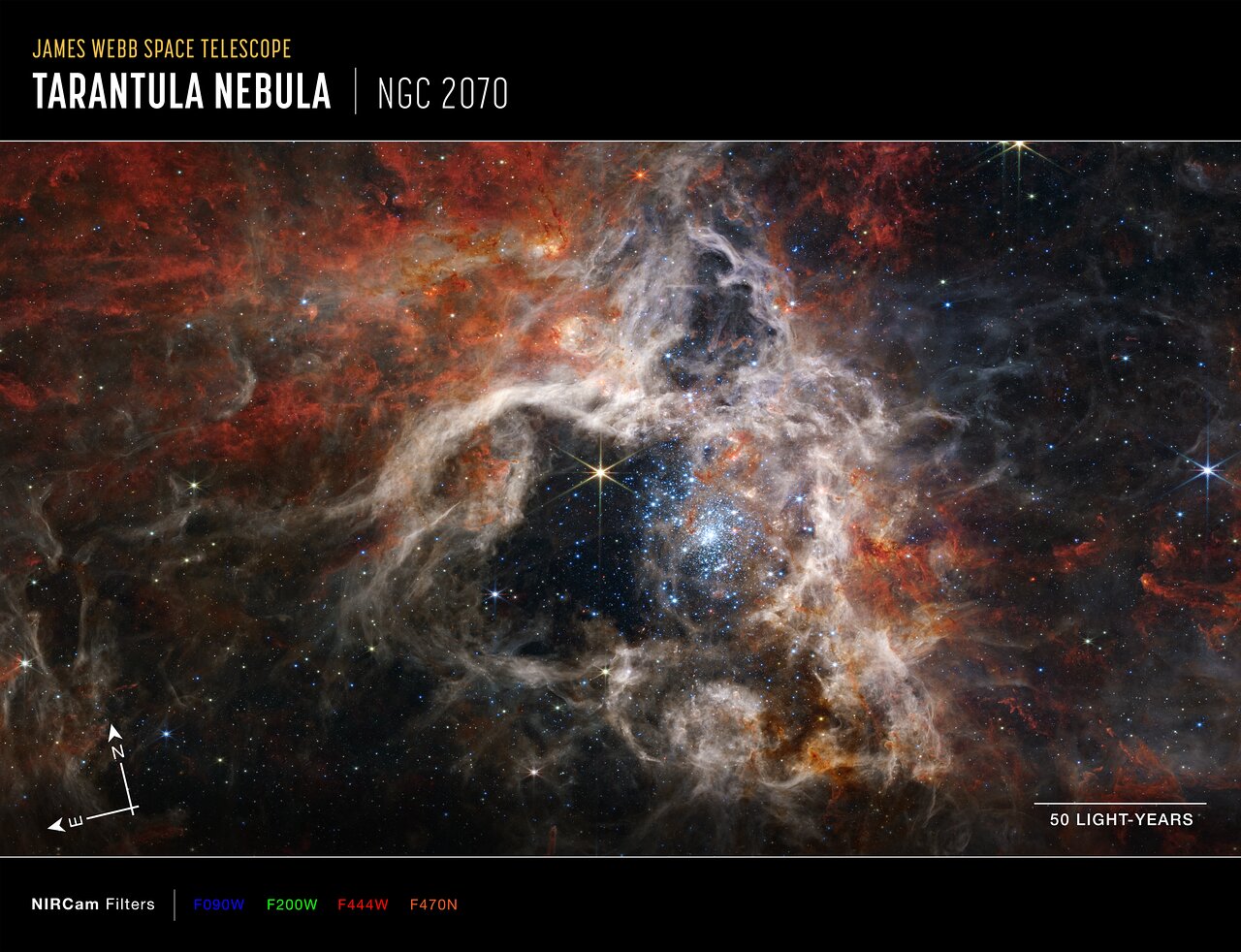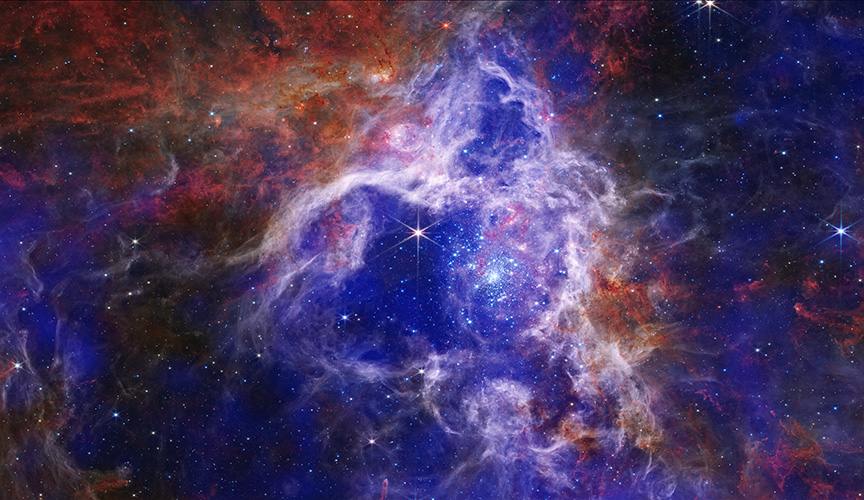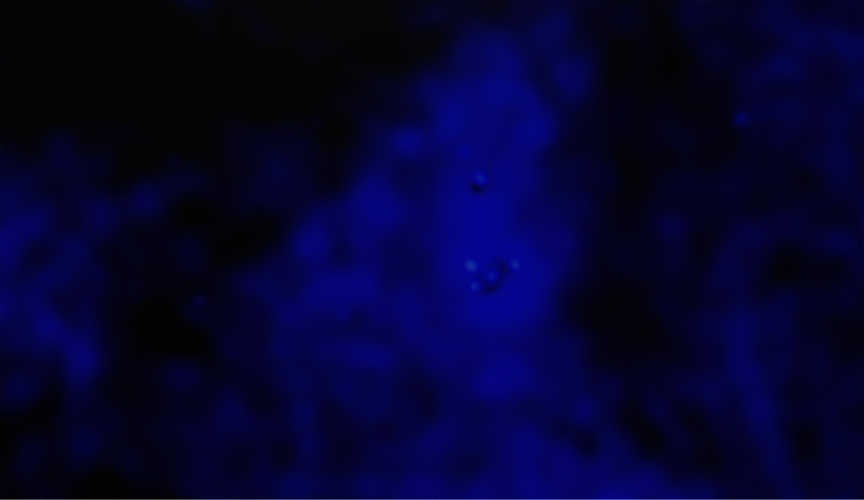James Webb Space Telescope Discovery
Clicking on each image will open the full resolution one. Try it!Clicking on "Raw images" image will yield all the relevant raw images.
Tarantula Nebula
In this mosaic image stretching 340 light-years across, Webb’s Near-Infrared Camera (NIRCam) displays the Tarantula Nebula star-forming region in a new light, including tens of thousands of never-before-seen young stars that were previously shrouded in cosmic dust. The most active region appears to sparkle with massive young stars, appearing pale blue. Scattered among them are still-embedded stars, appearing red, yet to emerge from the dusty cocoon of the nebula. NIRCam is able to detect these dust-enshrouded stars thanks to its unprecedented resolution at near-infrared wavelengths.
To the upper left of the cluster of young stars, and the top of the nebula’s cavity, an older star prominently displays NIRCam’s distinctive eight diffraction spikes, an artefact of the telescope’s structure. Following the top central spike of this star upward, it almost points to a distinctive bubble in the cloud. Young stars still surrounded by dusty material are blowing this bubble, beginning to carve out their own cavity. Astronomers used two of Webb’s spectrographs to take a closer look at this region and determine the chemical makeup of the star and its surrounding gas. This spectral information will tell astronomers about the age of the nebula and how many generations of star birth it has seen.
Farther from the core region of hot young stars, cooler gas takes on a rust colour, telling astronomers that the nebula is rich with complex hydrocarbons. This dense gas is the material that will form future stars. As winds from the massive stars sweep away gas and dust, some of it will pile up and, with gravity’s help, form new stars.
Credit: NASA, ESA, CSA, and STScI
 Tarantula Nebula (NIRCam Image)
Tarantula Nebula (NIRCam Image)
 At the longer wavelengths of light captured by its Mid-Infrared Instrument (MIRI), Webb focuses on the area surrounding the central star cluster and unveils a very different view of the Tarantula Nebula. In this light, the young hot stars of the cluster fade in brilliance, and glowing gas and dust come forward. Abundant hydrocarbons light up the surfaces of the dust clouds, shown in blue and purple. Much of the nebula takes on a more ghostly, diffuse appearance because mid-infrared light is able to show more of what is happening deeper inside the clouds. Still-embedded protostars pop into view within their dusty cocoons, including a bright group at the very top edge of the image, left of centre.
Other areas appear dark, like in the lower-right corner of the image. This indicates the densest areas of dust in the nebula, that even mid-infrared wavelengths cannot penetrate. These could be the sites of future, or current, star formation.
At the longer wavelengths of light captured by its Mid-Infrared Instrument (MIRI), Webb focuses on the area surrounding the central star cluster and unveils a very different view of the Tarantula Nebula. In this light, the young hot stars of the cluster fade in brilliance, and glowing gas and dust come forward. Abundant hydrocarbons light up the surfaces of the dust clouds, shown in blue and purple. Much of the nebula takes on a more ghostly, diffuse appearance because mid-infrared light is able to show more of what is happening deeper inside the clouds. Still-embedded protostars pop into view within their dusty cocoons, including a bright group at the very top edge of the image, left of centre.
Other areas appear dark, like in the lower-right corner of the image. This indicates the densest areas of dust in the nebula, that even mid-infrared wavelengths cannot penetrate. These could be the sites of future, or current, star formation.
 A side-by-side display of the same region of the Tarantula Nebula brings out the distinctions between Webb’s near-infrared (closer to visible red, left) and mid-infrared (further from visible red, right) images. Each portion of the electromagnetic spectrum reveals and conceals different features, making data in different wavelengths valuable to astronomers for understanding the physics taking place.
A side-by-side display of the same region of the Tarantula Nebula brings out the distinctions between Webb’s near-infrared (closer to visible red, left) and mid-infrared (further from visible red, right) images. Each portion of the electromagnetic spectrum reveals and conceals different features, making data in different wavelengths valuable to astronomers for understanding the physics taking place.
 Webb’s Near-Infrared Spectrograph (NIRSpec) reveals what is really going on in an intriguing region of the Tarantula Nebula. Astronomers focused the powerful instrument on what looked like a small bubble feature in the image from Webb’s Near-Infrared Camera (NIRCam). However, the spectra reveal a very different picture from a young star blowing a bubble in its surrounding gas.
The signature of atomic hydrogen, shown in blue, shows up in the star itself but not immediately surrounding it. Instead, it appears outside the “bubble,” which spectra show is actually “filled” with molecular hydrogen (green) and complex hydrocarbons (red). This indicates that the bubble is actually the top of a dense pillar of dust and gas that is being blasted by radiation from the cluster of massive young stars to its lower right (see the full NIRCam image). It does not appear as pillar-like as some other structures in the nebula because there is not much colour contrast with the area surrounding it.
The harsh stellar wind from the massive young stars in the nebula is breaking apart molecules outside the pillar, but inside they are preserved, forming a cushy cocoon for the star. This star is still too young to be clearing out its surroundings by blowing bubbles – NIRSpec has captured it just beginning to emerge from the protective cloud from which it was formed. Without Webb’s resolution at infrared wavelengths, the discovery of this star birth in action would not have been possible.
Webb’s Near-Infrared Spectrograph (NIRSpec) reveals what is really going on in an intriguing region of the Tarantula Nebula. Astronomers focused the powerful instrument on what looked like a small bubble feature in the image from Webb’s Near-Infrared Camera (NIRCam). However, the spectra reveal a very different picture from a young star blowing a bubble in its surrounding gas.
The signature of atomic hydrogen, shown in blue, shows up in the star itself but not immediately surrounding it. Instead, it appears outside the “bubble,” which spectra show is actually “filled” with molecular hydrogen (green) and complex hydrocarbons (red). This indicates that the bubble is actually the top of a dense pillar of dust and gas that is being blasted by radiation from the cluster of massive young stars to its lower right (see the full NIRCam image). It does not appear as pillar-like as some other structures in the nebula because there is not much colour contrast with the area surrounding it.
The harsh stellar wind from the massive young stars in the nebula is breaking apart molecules outside the pillar, but inside they are preserved, forming a cushy cocoon for the star. This star is still too young to be clearing out its surroundings by blowing bubbles – NIRSpec has captured it just beginning to emerge from the protective cloud from which it was formed. Without Webb’s resolution at infrared wavelengths, the discovery of this star birth in action would not have been possible.
 Tarantula Nebula (NIRCam Image - Annotated)
Tarantula Nebula (NIRCam Image - Annotated)
 Tarantula Nebula (MIRI Image - Annotated)
Tarantula Nebula (MIRI Image - Annotated)
 Chandra X-ray Observatory teamed up with the Webb telescope to create a new stunning composite image of the Tarantula Nebula. Chandra's X-rays (shown in royal blue and purple) identify extremely hot gas and supernova explosion remnants, while Webb reveals forming baby stars.
Unlike most nebulas in our Milky Way, the Tarantula Nebula has a chemical composition similar to that of conditions in our galaxy several billion years ago — when star formation was at its peak. For astronomers, this nebula is the perfect window into how stars formed in our galaxy in the distant past.
Image credit: X-ray: NASA/CXC/Penn State Univ./L. Townsley et al.; IR: NASA/ESA/CSA/STScI/JWST ERO Production Team
Chandra X-ray Observatory teamed up with the Webb telescope to create a new stunning composite image of the Tarantula Nebula. Chandra's X-rays (shown in royal blue and purple) identify extremely hot gas and supernova explosion remnants, while Webb reveals forming baby stars.
Unlike most nebulas in our Milky Way, the Tarantula Nebula has a chemical composition similar to that of conditions in our galaxy several billion years ago — when star formation was at its peak. For astronomers, this nebula is the perfect window into how stars formed in our galaxy in the distant past.
Image credit: X-ray: NASA/CXC/Penn State Univ./L. Townsley et al.; IR: NASA/ESA/CSA/STScI/JWST ERO Production Team
 X-ray only
X-ray only
 Raw images
Raw images